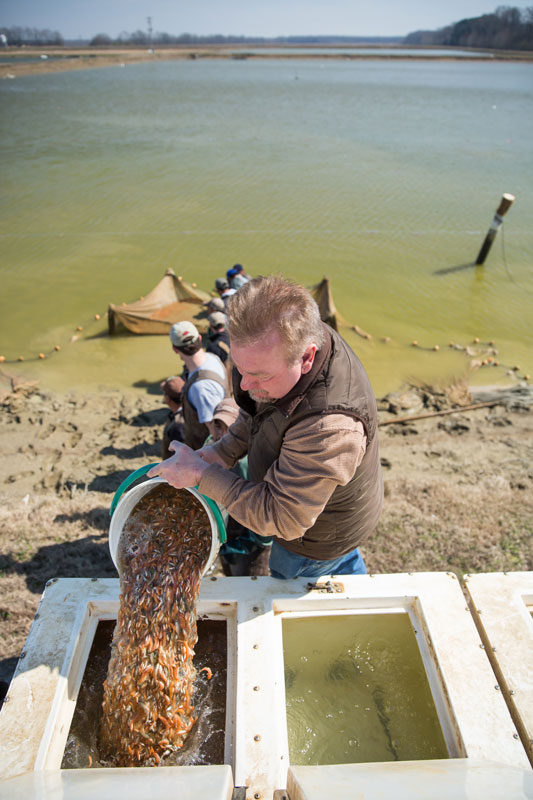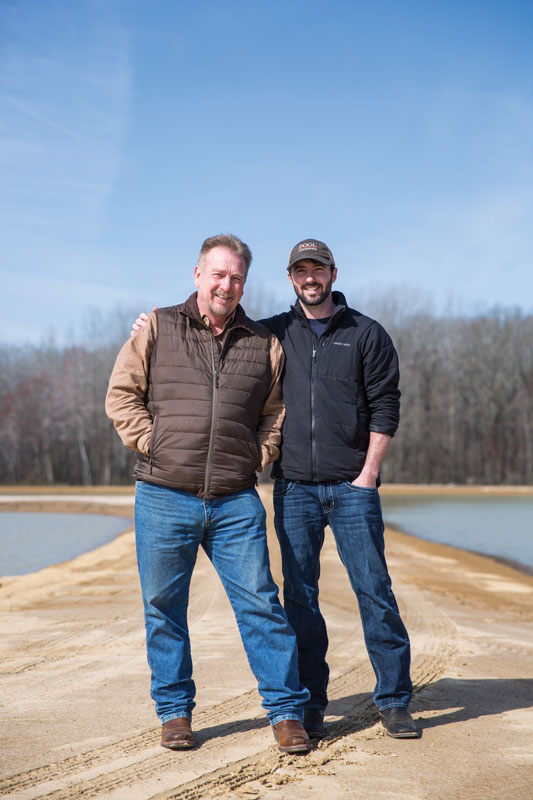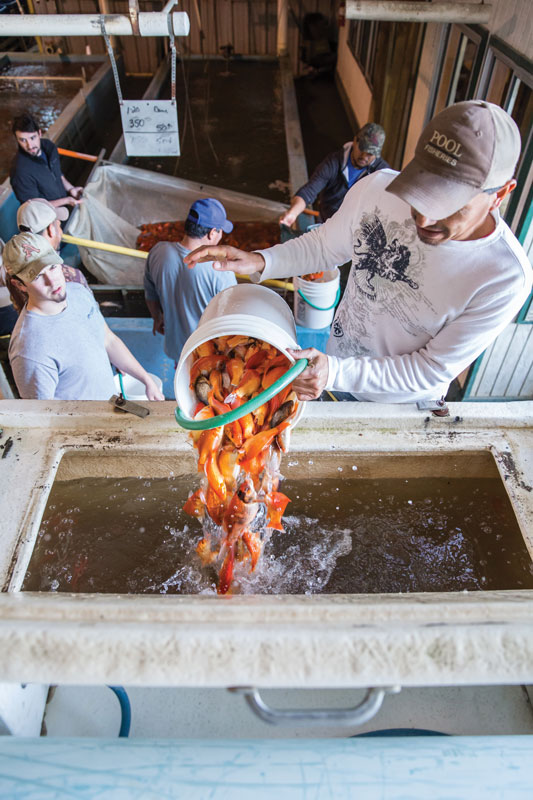
Angling for a Turnaround
April 20, 2018
Written By Adam Buckallew
Driving along the grassy levees separating a half-dozen goldfish ponds in central Arkansas, Landon Pool points out the paths too dangerous to traverse by pickup truck. Pool, a 30-year-old fish farmer, is surveying the land he purchased last year, making note of the eroding earthen walls and the work it will take to repair them. These levees need rebuilding, but they’re hardly Pool’s only concern. He’s preparing to take over a family business that’s on the decline, and people are counting on him to turn it around.

Since the age of 10, Landon has worked for his father, Danny, at Pool Fisheries, the world’s largest goldfish hatchery. The Pools ship 4 million fish per week and command approximately 80 percent of the goldfish market in the United States. If you’ve seen one of the brilliantly colored swimmers at a PetSmart, Wal-Mart, your local pet store or even in a baggie as a carnival prize, it likely came from the Pools’ fish farm based in Lonoke, Ark.
While the fish market is still doing relatively fine, demand has been slipping. By Danny’s estimates, the fishery’s sales have dropped 10 percent each year for the last five years. There’s no hard evidence to prove it, but Danny blames the rise of the Internet. In the battle for people’s leisure time attention, aquariums are heavy underdogs to Netflix. The trend is worrisome enough that the elder Pool had serious doubts about allowing his son to follow in his footsteps.
“I could see where the company was heading, and I didn’t want Landon to take on that burden,” Danny says. “I didn’t want to set him up for failure.”
Undeterred by the slumping fish market and his father’s hesitancy, Landon has remained steadfast in his decision to take the reins of the family’s goldfish empire. He’s been working toward said goal for years, and he is well-aware of the responsibility he’s undertaking.
“There’s no question, it’s a lot of pressure,” Landon says. “We have so many families that rely on us. I want to keep things going. There’s the family legacy, sure, but I’m more concerned with taking care of our employees.”
Fortunately for Landon, there’s still time to steer the company in a more positive direction, and this won’t be the first instance in which the Pool family has had to adapt its fishery business to remain competitive.
Pool Fisheries was founded in 1959 by Ruben Pool, who is regarded in the fish farming community as a pioneer of the industry. He was among the men who constructed the state’s first fish hatcheries during the Great Depression, and the knowledge and experience he gained in the process were put to good use when he bought a 40-acre farm on the outskirts of Lonoke. He started out raising minnows and catfish. However, it wasn’t long before other farmers flooded the market with those species, so Ruben and his son, Lon, switched to raising goldfish and Israeli carp instead.
Today, Pool Fisheries’ operations encompass 1,800 acres of land covered with more than 300 ponds of varying sizes. Most ponds cover between two to five acres of surface area. The vast majority of the ponds are home to goldfish, many of which are “comets,” a variety distinguished by a deeply forked tail. Other ponds hold albino fathead minnows and rosy red minnows, fish commonly bought by anglers for use as bait.
Danny, who has run the family farm for the past 30 years with his brother, Ronnie, has introduced his own changes to boost profits. He set up a distribution company to handle deliveries to customers by truck, which cut costs and provided better care for the millions of tiny swimmers distributed across the country.
“Trucking our own fish and custom-hauling for other fish farmers who aren’t in competition with us helped to cut our delivery costs in half,” Danny says. “It not only got our fish delivered cheaper, it also improved our quality.”
It wasn’t long before Danny discovered another opportunity to improve the logistics of the company’s long-range deliveries. The fishery began air mailing fish to long-distance customers and eventually ramped up to shipping 65,000 pounds of freight every week.
“We were FedEx’s largest customer before Amazon got as big as it is now,” Danny says. “Our sales have gone down while (Amazon’s) have gone up. We have to pay more in air freight now that FedEx isn’t as willing to give us as good of a deal. We’re paying twice what we used to pay to ship fish by air. Some of those charges have been passed on to our customers, but we can only pass on so much. It’s heavily cut into our margins.”
There is no shortage of resources at Landon’s disposal to revitalize Pool Fisheries, which sits in prime fish-hatching country. Three naturally occurring factors make central Arkansas the Shangri-La of warm water fish production in the United States.
- It’s a geographic sweet spot. The Natural State’s climate is ideal for fish production. The growing season is just the right length—allowing plenty of time for fish farmers to raise their annual crop, yet not so much time that the fish grow beyond market sizes.
- The soil holds water like no other. Dig down through about a foot of top soil in Lonoke County and you are likely to hit thick red clay. The watertight clay is excellent for water retention in levee ponds and provides suitable building material for levees.
- Fish love the local groundwater. Pool Fisheries relies on well water drawn from the Mississippi River Valley Alluvial Aquifer to fill its ponds. The water has optimal levels of alkalinity and pH, which the Pools say helps their fish thrive.
These natural resources are significant, but the guidance Landon has received from his father is equally important. Danny has shared his decades of expertise in rearing aquatic animals with his son while encouraging fresh thinking.
“Landon used to come to me and say, ‘Dad, why don’t you try this,’ and I’d tell him, ‘Great idea, you need to do that. This is all going to be yours soon,’” Danny says. “The company needs to evolve. That’s how we have grown and survived throughout the years. When your sales and profits go down, you’ve got two choices. You can downsize, or you can try and reinvent the business by growing some different things. We are at that point. The time for change is here.”
Danny and Landon struck an agreement. So long as Landon agreed to earn a college degree in business, Danny would support his decision to return to the farm. Landon fulfilled his part of the bargain in 2010 and within a year of graduation began operating his own fish farm. Danny lent Landon two ponds on four acres to get his son started, and Landon’s operation has since expanded to a total of 80 ponds.
Rather than mimic Pool Fisheries’ focus on feeder and bait fish, Landon has branched out. He grows several varieties of ornamental goldfish. The market for these fancy goldfish is smaller, but they sell at premium prices. Raising specialty breeds such as Black Moors, Bubble Eyes, Shubunkins and Sarasas has allowed Landon to experiment while testing the viability of new markets. It’s one of the ways he’s looking to energize sales in the face of the stagnating feeder fish market.
Landon bought a rundown fish farm to handle his growing ornamental goldfish business. He’s been farming half of it and making repairs on the other half as he goes. The jump into fancies has allowed him to diversify without venturing too far from what he is most familiar with, he says. Landon isn’t opposed to one day moving out of his comfort zone into other species like catfish, bass, crappie or even crawfish, but it would require a major investment.
“Switching from feeder goldfish to fancies was easy since the setup needed to grow them is pretty much the same,” Landon says. “If we were to move into other types of fish, we would need to be sure of our ability to be successful, because we could be looking at a lot of expenses.”
Catfish, for example, require different nets, equipment and tanks, not to mention deeper ponds. Such considerations make species selection one of the most important decisions a fish farmer makes. Every species has its own set of biological and economic potential and constraints. Additionally, there must be a market for the fish, or the farmer has to put in the work to develop one.
“If you try to do a new market and you can’t supply it, you can’t develop it,” Danny says. “At the same time, you don’t want to put hundreds of acres into production for a new species if you don’t know if you can sell it. It’s a balancing act. You can’t walk into a new market too slowly.”
Despite the difficulty and expense of developing new markets, Landon remains optimistic. He lists aquatic plants and hydroponics as other avenues he’s researching.
“There’s lots of opportunity and promising possibilities out there, I just need to figure out which direction we need to go,” Landon says.
Given Pool Fisheries air freight capabilities, Landon is also investigating the feasibility of direct sales via the Internet.
“We already have the ability to ship fish by air, so why not sell direct?” Landon says. “That’s part of the reason why I’ve started raising the fancy goldfish. If we go that route, we will need to offer a wider selection of fish.”
Every spring, 3 billion fish are spawned at Pool Fisheries. The goldfish business is a numbers game, and successful spawning is critical to ensuring there will be enough fish to market for the year. The fish are stocked densely. Roughly a million fish swim in each acre of pond water because only one out of 10 is likely to survive.
 Pool Fisheries employees prepare to set up a seine to catch fish. Once the fish are caught in the net, they are scooped out in buckets to a tanker truck.
Pool Fisheries employees prepare to set up a seine to catch fish. Once the fish are caught in the net, they are scooped out in buckets to a tanker truck. Pool Fisheries employees prepare to set up a seine to catch fish. Once the fish are caught in the net, they are scooped out in buckets to a tanker truck.
Pool Fisheries employees prepare to set up a seine to catch fish. Once the fish are caught in the net, they are scooped out in buckets to a tanker truck. Pool Fisheries employees prepare to set up a seine to catch fish. Once the fish are caught in the net, they are scooped out in buckets to a tanker truck.
Pool Fisheries employees prepare to set up a seine to catch fish. Once the fish are caught in the net, they are scooped out in buckets to a tanker truck.
The list of predators looking to snack on goldfish is extensive. Various insects are the primary threat within a fish’s first 10 days of life. What the bugs fail to eat, the birds, ducks, cranes, crawfish, turtles, snakes, raccoons, frogs and even other goldfish may devour.
“They are called feeder fish for a reason: everything eats them,” Danny says. “It’s nature, man. We know we have to produce the fish at high numbers to make up for that. That’s why we start with 3 billion to get to 300 million.”
Spawning season is by far the busiest time of the year at the fishery. Putting out billions of fish in a roughly two-month span is a tall task. To handle the time crunch, the Pools workforce swells from 30 to 70 employees. High school and college students will combine with temporary agricultural workers from Mexico to reinforce the fishery’s regulars in the effort.
When Landon thinks of those employees, many of whom he’s grown up working alongside, it further reinforces his determination to reverse the fishery’s sliding sales.
“It’s a big responsibility, having so many families depending on you and the business you manage,” Landon says. “That’s why I’m focused on finding new markets to keep the company going. If everything works out the way I’m hoping, we should start growing again. We’ve just got to keep evolving. That’s how this company has grown and survived throughout the years. Now, it’s time to do it again.”








